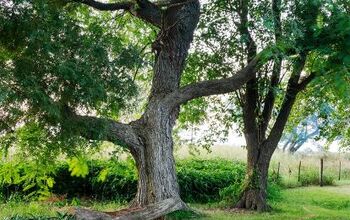What Are The Pros and Cons Of Royal Empress Trees?

Named for Russian Princess Anna Pavlovna, Royal Empress Trees are kind of a miracle. They grow at a rate unmatched by any other tree and don’t care a lick what kind of soil they’re in. Some classify them as exotic invasive plants. Others are awed by their unique beauty and grand presence. I’ll let you decide.
Royal Empress Trees grow 10 feet or more in a single season and live up to 70 years. This Asian native thrives in any soil and weather conditions. Its leaves offer an abundance of shade so dense that nothing can grow beneath it. Prone to mess, it constantly drops brittle branches, leaves, and seeds. In some areas, it’s illegal to plant these trees.
Do You Need Landscaping Services?
Get free, zero-commitment quotes from pro contractors near you.

Royal Empress Trees
Native to Asia, Royal Empress Trees grow in the United States in plant hardiness zones 5 through 9. While they are a favorite of gardeners, some US governments won’t allow Royal Empress Trees to be planted.
They come in a variety of species, some of which aren’t as invasive, but some communities don’t differentiate between species. If you plant an invasive tree without permission, you could be subject to fines. It’s best to check with your local government before planting these trees.
Appearance
With a smooth, dark gray trunk and uniquely textured leaves, Royal Empress Trees rival the beauty of other deciduous trees like aspens.
Leaves
Royal Empress Trees have fuzzy, heart-shaped leaves that can have up to five lobes and offer an abundance of shade. However, the leaves are so dense that no sunlight can seep through, making it impossible to grow anything beneath their spread.
Young trees don’t get flowers, but their leaves can measure up to 16 inches wide. These oversized leaves are the reason for one of its nicknames—Jack and the Beanstalk tree. The leaves on mature trees are a bit smaller, measuring 5-10 inches. In the fall, they turn from light green to shades of gold.
Con: Royal Empress Trees drop their leaves (and other debris) regularly which requires constant clean-up. Otherwise, you’re left with a giant mess.
Pro: These leaves are not the first choice of food for deer. They will only eat the leaves if nothing else is available. After the tree reaches a height of six feet, you won’t see any leaf-eating issues from deer or other animals.
Flowers
Just as their leaves inspired one of the tree’s nicknames, so, too, do its flowers. Also known as a foxglove tree, it blooms in spring, revealing violet flowers with yellow stripes and dark spots.
The rust-color flower buds actually appear in winter and stand erect just before the leaves appear in the spring. When they bloom—if they ever bloom—the flowers smell heavily like vanilla. Because the buds appear so early, they tend to die off before they even bloom. However, when they bloom in abundance, the flowers produce nut-like fruit that measures 2-3 inches long.
Con: While the mess of most trees is gone by winter, the seeds of a Royal Empress can last through the cold season, falling and littering the yard.
Growth Rate
Royal Empress Trees are one of the most hated plants because their fast growth rate classifies them as invasive. But regardless of your feelings toward Royal Empress Trees, their growth rate is kind of amazing.
In a single season, Royal Empress Trees can grow 10 feet or more! Many people choose to plant them for their quick results. A mature tree measures 30-50 feet high and 20-30 feet wide. Some even reach up to 80 feet in height and spread.
Royal Empresses have a lifespan averaging 40-70 years, though some live up to 150 years.
Con: Their quick growth makes for brittle branches that snap off easily in wind and ice, causing lots of debris.
Con: Their roots are exceptionally aggressive. They are shallow and grow horizontally which poses a high risk of property damage.
Pro: Royal Empress Trees grow too fast for diseases or pests to cause any damage to them.
Hardiness
Some say hardy. Some say invasive. Either way you swing it, Royal Empress Trees can thrive in the most difficult of circumstances.
They can tolerate a wide range of soil conditions, unlike most trees. While they prefer deep, well-drained soil, they can also thrive in clay, sand, and soil with high levels of acidity and alkaline. They aren’t bothered by sea spray, saline soil, or pollution. However, they do require direct sunlight for optimum growth.
Pro: Royal Empress Trees can survive drought, fire, lightning strikes, and many other harsh conditions. There are amazing stories of trees growing from stumps and new roots forming after being uprooted.
Con: If you’re on the invasive team, you’ll be happy to know that some governments classify these trees as weeds. And they won’t allow them to be planted in residential yards. Once a Royal Empress Tree is established, it’s almost impossible to remove it. Every single inch of the tree—tree, stump, and roots—must be removed to ensure it won’t grow back.
Invasiveness
In southern and southeastern parts of the US, Royal Empress Trees have become incredibly invasive. Their seeds germinate rapidly and they also reproduce from sprouts. The sprouts can grow 15 feet in a season. From there, the trees form colonies that overwhelm native vegetation. Once established, these colonies are very difficult to move.
Additional Pros
It may seem like there’s more bad than good when it comes to Royal Empress Trees. However, they have other positive attributes that are worth noting.
They can handle a lot of pruning. After the first year, some gardeners cut the tree all the way to the ground to encourage it to grow more upright. And their stubborn will to thrive allows them to grow from almost nothing.
Their wood has a lot of uses. Because of how quickly they grow, farmers often grow Royal Empress Trees as a cash crop. The wood is good for musical instruments, housing material, flooring, furniture, and other hardwood products. The Japanese value this wood most for sandal-making.
Cultural Significance
The Japanese have a beautiful tradition surrounding Royal Empress Trees. At the birth of a daughter, the family will plant this tree. It grows as she does. When the time comes for her to marry, the tree is cut down and its wood is used to make items for her dowry.
Royal Empress Tree Pros and Cons
Here is a comparison chart of the pros and cons of the Royal Empress Tree.
| Pros | Cons |
| Leaves are not often eaten by animals and give off tons of shade. | Leaves, flowers, branches, and seeds drop throughout the year, leaving a messy area around the tree. |
| Fast growth rate means more instantaneous results for those who want mature landscaping. It also grows too fast for disease or pests to cause them damage. | Buds appear so early that frost may nip them before they bloom. |
| They can handle a lot of pruning and can be encouraged to grow more upright. | Roots grow aggressively and cause potential risk for property damage. |
| They can withstand any soil and weather conditions. | Classified as invasive in some areas and aren’t permitted to be planted. |
| Their wood has a lot of uses and is planted as a cash crop for some farmers. | They are very difficult to remove completely. |
Related Questions
Are Royal Empress Trees poisonous?
Unlike the standard foxglove tree, the leaves of the Royal Empress are not poisonous to animals. Therefore, this species is safe to plant if you have pets.
How do you prune a Royal Empress Tree?
Locate any branches with poor collar attachment and remove them. Prune any low-hanging branches that prevent you from passing beneath the tree. For a crooked tree, cut it all the way down to the ground. As it re-grows, cut back everything except the strongest shoot. This encourages the tree to grow straighter.
Can you eat Empress Tree fruit?
The fruit of an Empress Tree is a dry fruit that contains thousands of tiny winged seeds that eventually disperse. It’s unclear whether or not the fruit is edible. However, the known edible parts of the tree include its leaves and flowers. The flowers, particularly, are often used in salads or eaten with miso. The leaves are more or less an emergency food if you’re stuck in the woods with nothing else around. They should be cooked.
How do I get rid of Royal Empress Tree roots?
To get rid of the roots, apply a liquid herbicide to the surface and directly surrounding area. Roughly 20% of the area around the stump should be covered. But take care not to let the herbicide run too far or you risk killing other vegetation in the vicinity.
Do You Need Landscaping Services?
Get free, zero-commitment quotes from pro contractors near you.

Summing It Up
You have to be 100% confident in your decision to plant a Royal Empress Tree—assuming you’re allowed. Once its roots have been established, you will have great difficulty getting rid of it if you change your mind.
They are invasive and messy, and you may never see their flowers bloom. But they provide tons of shade and beautifully colored leaves in the fall.
Related Guides

Brigid Levi is a wife, mother, and freelance writer who enjoys a good DIY project and creating beautiful spaces within her home. From cleaning and organization hacks to home decor ideas, she loves helping people in their quest to turn a house into a home. Her hobbies include pretending to be Joanna Gaines while updating her home with her husband and performing in local theater productions.
More by Brigid Levi














![10 Best Zero Turn Mowers – [2022 Reviews & Ultimate Buyer's Guide]](https://cdn-fastly.upgradedhome.com/media/2023/07/31/9070522/10-best-zero-turn-mowers-2022-reviews-ultimate-buyer-s-guide.jpg?size=350x220)












